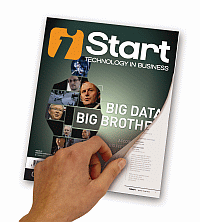Published on the 22/09/2013 | Written by

INSIDE THIS ISSUE: Case Studies: Not for profit, Agriculture, Marine, Local Government, Food Manufacturing. Features: Big data big brother, accounting for time, banking: big fees and big mergers, top 10 apps for business + 2013 BI Buyer’s Guide.[View eMag]
EDITORIAL: We are living in interesting times – times that are redefining the world we live in. Today, there is little definition between public and private; companies, governments and criminals alike exploit all they know about us to further their various capitalist, protective and nefarious agendas. The intersection of big data, government and high-tech computing has privacy advocates up in arms. The technology should really come with a moral compass as lobbyist Paul Brislen points out on p34. But while the general media is in a flap about conspiracy theories and protesters line the streets to dispute the powers of security agencies around the world, it is easy to forget that the big data story is more nuanced. On a happier note, however, the case studies in this issue show how much good insights into your data can do for business. Take carbon fibre marine components manufacturer, C-Tech, for example. It had to re-engineer the focus of its business when the market for its battens used in the America’s Cup shrank in line with changes to the rules governing the competition boats’ configuration. Without a new ERP system, it would have been a struggle (p38). Or quality improvement organisation, AGPAL, that does accreditation for general medical practices. It needed to be able to focus on its clients’ needs not administration and a new ERP’s open data standards helped (p28). For every concern you have in business there is a technology solution and you could go crazy buying them all. I think, though, the real trick is to know where you want your business to be in five years’ time and map technology in to your plans. The ANZ and National banks merger in New Zealand is a prime example of good leadership delivering good results in this respect (p46). With the mega trends of ubiquitous high speed broadband; cloud computing; big data and analytics; mobility; interface and collaboration technologies; and intelligent systems, sensors and robots all intertwining to re-shape our futures, the next era of business will challenge our ethical boundaries as much as present new digital business paradigms. Enjoy the read. Clare Coulson
We might feel heartily sick of the ‘big data’ buzzword in the business world, especially when people are just spouting marketing puffery, but scratch beneath the surface and the reality is more compelling, as our feature ‘Is big data “bullshit”?’ sets out to demonstrate on p16. And, provocation aside, the results of information falling into the wrong hands can be significant (see Cybercrime – p30).
iStart Editor



























